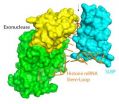(Press-News.org) Wild animals may be a key contributor to the continuing spread of African sleeping sickness, new research published in PLOS Computational Biology shows. The West African form of the disease, also known as Gambiense Human African trypanosomiasis, affects around 10,000 people in Africa every year and is deadly if left untreated.
The disease is caused by a brain-invading parasite transmitted by bites of the tsetse fly, and gets its name from the hallmark symptoms of drowsiness and altered sleeping patterns that affect late-stage patients, along with other physical and neurological manifestations including manic episodes and hallucinations that eventually lead to coma and death.
Despite numerous previous studies showing that animals can be infected with the parasite, the prevailing view has been that the disease persisted in its traditional areas almost only because of human-to-human transmission. A new study, from an international team of researchers led by the London School of Hygiene & Tropical Medicine, challenges this assumption by using a mathematical model to show that the disease not only can persist in an area even when there are no human cases, but probably requires the presence of infected wild animals to maintain the chain of transmission. The authors' model was based on data collected in active screening campaigns between November 1998 and February 1999 in the Bipindi area of Cameroon. One of the species in the data group was the White-eyelid mangabey, pictured below.
The research provides an attractive explanation for why sleeping sickness survives in places which have undergone intensive efforts to find and treat infected people in the community. It suggests that efforts to eliminate the disease must factor in the wild animal populations.
"This research suggests that targeting human populations alone, the main current control strategy, might not be enough to control the disease," says Sebastian Funk, the lead author of the study. "Maintenance of transmission in wild animal populations could explain the reappearance of sleeping sickness in humans after years without cases."
###
Contact:
Dr. Sebastian Funk
Princeton University
Ecology and Evolutionary Biology
106A Guyot Hall
Princeton, NJ 08544
UNITED STATES
Email: sf7@princeton.edu
Phone: +44 7726 026766
Financial disclosure: SF was supported by EU FP7 funded integrated project EPIWORK (grant agreement number 231807). HN was supported by the JST PRESTO program. FC was supported by an AXA Research Fund Post-Doctoral Fellowship. This work was also assisted through participation in the Mathematical Modeling of Wildlife Zoonoses Investigative Workshop at the National Institute for Mathematical and Biological Synthesis, sponsored by the National Science Foundation, the U.S.
Department of Homeland Security, and the U.S. Department of Agriculture through NSF Award #EF-0832858, with additional support from The University of Tennessee, Knoxville. The funders had no role in study design, data collection and analysis, decision to publish, or preparation of the manuscript.
Competing interests: The authors have declared that no competing interests exist.
Citation: Funk S, Nishiura H, Heesterbeek H, Edmunds WJ, Checchi F (2013) Identifying Transmission Cycles at the Human-Animal Interface: The Role of Animal Reservoirs in Maintaining Gambiense Human African Trypanosomiasis. PLoS Comput Biol 9(1): e1002855. doi:10.1371/journal.pcbi.1002855
Please add this link to the freely available article in online versions of your report (the link will go live when the embargo ends):
http://www.ploscompbiol.org/doi/10.1371/journal.pcbi.1002855
Disclaimer
This press release refers to an upcoming article in PLOS Computational Biology. The release is provided by journal staff, or by the article authors and/or their institutions. Any opinions expressed in this release or article are the personal views of the journal staff and/or article contributors, and do not necessarily represent the views or policies of PLOS. PLOS expressly disclaims any and all warranties and liability in connection with the information found in the releases and articles and your use of such information.
Media Permissions
PLOS Journals publish under a Creative Commons Attribution License, which permits free reuse of all materials published with the article, so long as the work is cited (e.g., Brinkworth RSA, O'Carroll DC (2009) Robust Models for Optic Flow Coding in Natural Scenes Inspired by Insect Biology. PLOS Comput Biol 5(11): e1000555. doi:10.1371/journal.pcbi.1000555). No prior permission is required from the authors or publisher. For queries about the license, please contact the relative journal contact indicated here: http://www.PLOS.org/about/media-inquiries/embargo-policy/
About PLOS Computational Biology
PLOS Computational Biology features works of exceptional significance that further our understanding of living systems at all scales through the application of computational methods. All works published in PLOS Computational Biology are open access. Everything is immediately available subject only to the condition that the original authorship and source are properly attributed. Copyright is retained.
About PLOS
PLOS is a non-profit organization of scientists and physicians committed to making the world's scientific and medical literature a freely available public resource. For more information, visit http://www.PLOS.org.
Everything published by PLOS Computational Biology is open access, allowing anyone to download, reuse, reprint, modify, distribute, and/or copy articles, so long as the original authors and source are cited. Please mention PLOS Computational Biology in your report and use the link(s) below to take readers straight to the online articles. Thank you.
Wild animals may contribute to the resurgence of African sleeping sickness
2013-01-18
ELSE PRESS RELEASES FROM THIS DATE:
Factors linked with survival differences between Black, White kidney failure patients
2013-01-18
Highlights
Residence in areas with higher average household income was linked with improved survival in kidney failure patients.
In White patients, income inequality was associated with mortality.
In Black patients exclusively, residence in highly segregated areas was associated with increased mortality.
More than 590,000 Americans in 2010 were treated for kidney failure.
Washington, DC (January 17, 2013) — Complex socioeconomic and residential factors may account for differences in survival between Black and White kidney failure patients, according to a study ...
Climate events drive a high-arctic vertebrate community into synchrony
2013-01-18
Climate change is known to affect the population dynamics of single species, such as reindeer or caribou, but the effect of climate at the community level has been much more difficult to document. Now, a group of Norwegian scientists has found that extreme climate events cause synchronized population fluctuations among all vertebrate species in a relatively simple high arctic community. These findings may be a bellwether of the radical changes in ecosystem stability that could result from anticipated future increases in extreme events. The findings are published in the ...
Scientists expose new vulnerabilities in the security of personal genetic information
2013-01-18
CAMBRIDGE, Mass. (January 17, 2013) – Using only a computer, an Internet connection, and publicly accessible online resources, a team of Whitehead Institute researchers has been able to identify nearly 50 individuals who had submitted personal genetic material as participants in genomic studies.
Intent on conducting an exercise in “vulnerability research”—a common practice in the field of information security—the team took a multi-step approach to prove that under certain circumstances, the full names and identities of genomic research participants can be determined, ...
Mouse research links adolescent stress and severe adult mental illness
2013-01-18
Working with mice, Johns Hopkins researchers have established a link between elevated levels of a stress hormone in adolescence — a critical time for brain development — and genetic changes that, in young adulthood, cause severe mental illness in those predisposed to it.
The findings, reported in the journal Science, could have wide-reaching implications in both the prevention and treatment of schizophrenia, severe depression and other mental illnesses.
"We have discovered a mechanism for how environmental factors, such as stress hormones, can affect the brain's physiology ...
Feed a cold, starve a fever…. and your worms!
2013-01-18
Contact:Gina Alvino
(415) 568-3173
plospathogens@plos.org
Disclaimer
This press release refers to an upcoming article in PLOS Pathogens. The release is provided by the article authors. Any opinions expressed in these releases or articles are the personal views of the journal staff and/or article contributors, and do not necessarily represent the views or policies of PLOS. PLOS expressly disclaims any and all warranties and liability in connection with the information found in the releases and articles and your use of such information.
Media Permissions
PLOS Journals ...
How the brain copes with multi tasking alters with age
2013-01-18
The pattern of blood flow in the prefrontal cortex in the brains alters with age during multi-tasking, finds a new study in BioMed Central's open access journal BMC Neuroscience. Increased blood volume, measured using oxygenated haemoglobin (Oxy-Hb) increased at the start of multitasking in all age groups. But to perform the same tasks, healthy older people had a higher and more sustained increase in Oxy-Hb than younger people.
Age related changes to the brain occur earliest in the prefrontal cortex, the area of the brain associated with memory, emotion, and higher decision ...
It's a dog's life: Doggy database aims to define pet health
2013-01-18
Using data collected about Labrador Retrievers, research published in BioMed Central's open access journal BMC Veterinary Research is beginning to quantify the health, illnesses, and veterinary care of dogs.
The UK is a nation of pet lovers – but what do we know about the health of our pets? To date the long term (longitudinal) study of canine diseases has been patchy, relying on information from referral centers and details about pet illnesses which are not reported to a vet have never been studied before.
The Dogslife internet-based project was organized in conjunction ...
Savanna study highlights African fuelwood crisis
2013-01-18
The dwindling reserves of fuelwood in Africa have been illuminated in a new study published today, which shows a bleak outlook for supplies across savannas in South Africa.
Presenting their findings in IOP Publishing's journal Environmental Research Letters, researchers have found that at current consumption levels in the communal areas of Lowveld, South Africa, reserves of fuelwood could be totally exhausted within 13 years.
The consequences are significant, with around half of the 2.4 million rural households in the country using wood as their primary fuel source, ...
Molecular twist helps regulate the cellular message to make histone proteins
2013-01-18
(Embargoed) CHAPEL HILL, N.C. – Histone proteins are the proteins that package DNA into chromosomes. Every time the cell replicates its DNA it must make large amounts of newly made histones to organize DNA within the nucleus.
An imbalance in the production of DNA and histones is usually lethal for the cell, which is why the levels of the messenger RNA (mRNA) encoding the histone proteins must be tightly controlled to ensure the proper amounts of histones (not too many and not too few) are made.
In a collaborative effort published online in the January 18, 2013 issue ...
Inadequate food facilities in NC migrant camps could cause illness
2013-01-18
WINSTON-SALEM, N.C. – Jan. 17, 2013 – Farmworkers are at potential risk from food and waterborne illnesses because of the condition of cooking and eating facilities available to them, according to a new study from Wake Forest Baptist Medical Center.
Researchers from Wake Forest Baptist are the first to evaluate cooking and eating facilities in migrant farmworker camps to compare against established housing regulations. They found that the facilities fail to comply with regulations in a substantial number of camps. The study, which appears online today in the January issue ...

